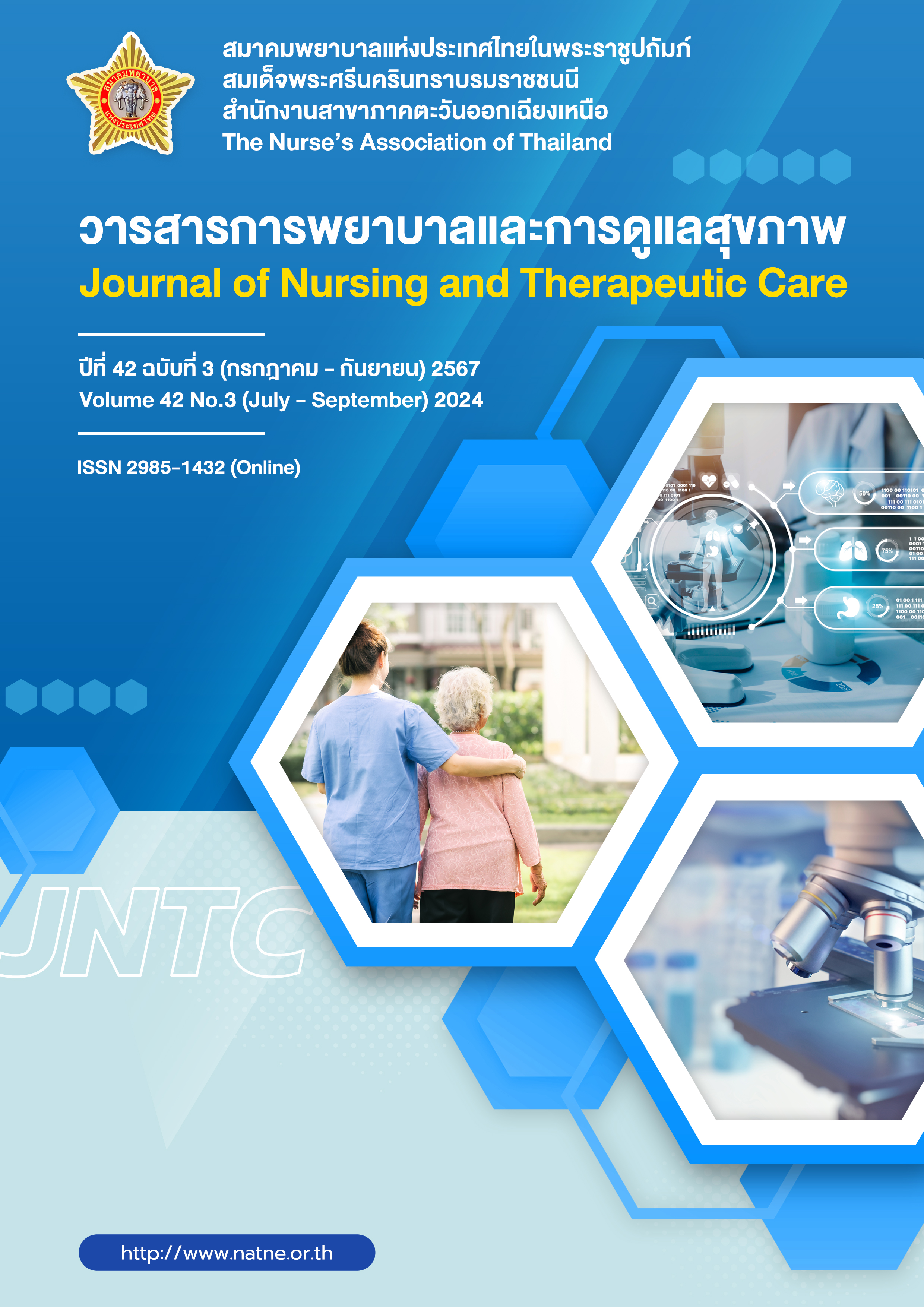การพัฒนารูปแบบการดูแลผู้ป่วยหลังการระงับความรู้สึกใน 24 ชั่วโมง ด้วยการพยาบาลทางไกล สถาบันราชประชาสมาสัย
คำสำคัญ:
รูปแบบการดูแลผู้ป่วยหลังการระงับความรู้สึกใน 24 ชั่วโมง, การพยาบาลทางไกลบทคัดย่อ
การวิจัยนี้มีวัตถุประสงค์เพื่อ พัฒนารูปแบบและประเมินผลลัพธ์ของรูปแบบ การดูแลผู้ป่วยหลังการระงับความรู้สึกใน 24 ชั่วโมง ด้วยการพยาบาลทางไกล สถาบันราชประชาสมาสัย โดยศึกษาในหอผู้ป่วยที่ดูแลผู้ป่วยหลังการระงับความรู้สึก การวิจัยแบ่งเป็น 4 ขั้นตอน 1) ศึกษาสภาพปัญหา และความต้องการ 2) ดำเนินการพัฒนารูปแบบฯ 3) ทดลองและปรับปรุงรูปแบบฯโดยการเลือกแบบเจาะจง ประกอบด้วย วิสัญญีพยาบาล จำนวน 3 คน พยาบาลหอผู้ป่วยที่ดูแลผู้ป่วยหลังการระงับความรู้สึก จำนวน 12 คน รวมทั้งสิ้น 15 คน และผู้ป่วยหลังการระงับความรู้สึกใน 24 ชั่วโมงที่หอผู้ป่วย จำนวน 25 คน 4) ประเมินผลการพัฒนารูปแบบฯ ด้วยการเก็บข้อมูลโดยผสานวิธีทั้งเชิงปริมาณและเชิงคุณภาพ เครื่องมือที่ใช้ในการดำเนินการวิจัยได้แก่ 1) แบบสัมภาษณ์เชิงลึก ตรวจสอบความตรงตามเนื้อหา โดยผู้ทรงคุณวุฒิ 3 คน ได้ค่าความเที่ยงตรงของแบบสอบถาม 0.89 2) เครื่องมือที่ใช้ในการเก็บรวบรวมข้อมูล ได้แก่ แนวทางสนทนากลุ่ม เพื่อดำเนินงานตามรูปแบบ และ 3) แบบประเมินความเหมาะสมและความพึงพอใจของรูปแบบ ได้ค่าความเที่ยงตรงของแบบสอบถาม 0.9 วิเคราะห์ข้อมูลเชิงปริมาณด้วยสถิติเชิงพรรณนา ข้อมูลเชิงคุณภาพใช้วิเคราะห์เนื้อหา
ผลการวิจัยพบว่า วิสัญญีพยาบาล และพยาบาลหอผู้ป่วยฯ สามารถติดต่อสื่อสารได้ภายใน 10 นาที ผู้ป่วยได้รับการพยาบาลเบื้องต้นภายใน 15 นาที และไม่เกิดภาวะแทรกซ้อนรุนแรงตามมา ผลลัพธ์ของการใช้รูปแบบ พบว่า วิสัญญีพยาบาลและพยาบาลหอผู้ป่วยฯ มีความคิดเห็นต่อความเหมาะสมและความพึงพอใจของรูปแบบโดยรวมในระดับมาก ประเด็นการติดต่อสื่อสารได้ทันที ตลอด 24 ชั่วโมงมีความเหมาะสมระดับมากที่สุด และมีความพึงพอใจในระดับมากที่สุดทุกประเด็น โดยสรุป รูปแบบนี้มีประโยชน์ต่อการดูแล ผู้ป่วยหลังการระงับความรู้สึกใน 24 ชั่วโมง งานวิสัญญีมีการดูแลผู้ป่วยหลังการระงับความรู้สึกตามมาตรฐาน และลดการเกิดภาวะแทรกซ้อนหลังการระงับความรู้สึกที่รุนแรงกับผู้ป่วยตามมา
Downloads
เอกสารอ้างอิง
Dermkhuntod N, Kwancharoen R, Chuantantikamol C, Paholpak P, Suraamornkul S. Effects of telehealth monitoring on glycemic control and medication adherence in patients with poorly controlled type 2 diabetes. Vajira Medical Journal: Journal of Urban Medicine. 2021.65 (Supplement):75-90 (in Thai).
Thailand Nursing and Midwifery Council. Tele-nursing. [Internet]. 2021. [cited 2023 Dec 14]. Available from: https://www.tnmc.or.th/. (in Thai).
Sriswang S, Punwilai J, Chaiinseeard S. Incidence of anesthetic complications at chiangmai neurological hospital, Fiscal Year 2014–2016. Journal of Health Systems Research. 2018;43(1):106-11. (in Thai).
Siripituphum D, Development of telenursing based caregiver transitional support program for Thai caregivers of persons with traumatic brain injury. [Internet]. 2020. [cited 2023 Dec 6]. Available from: https://kb.psu.ac.th/psukb/handle/2016/17694. (in Thai).
Upasri T, Prachusilpa G. A study of nurse anesthetist roles. Journal of The Royal Thai Army Nurses. 2022;23(1):494-501. (in Thai).
American Society of Anesthesiologists. Type of anesthesia care. [Internet]. 2024 [cited 2023 Dec 25]. Available from: https://www.asahq.org/madeforthismoment/anesthesia-101/types-of-anesthesia/.
American Society of Anesthesiologists. Practice guidelines for postanesthetic care [Internet]. 2013. [cited 2023 Dec 25]. Available from: https://pubs.asahq.org/anesthesiology/article/118/2/291/13600/Practice-Guidelines-for-Postanesthetic-Care An.
Suton P, Pongraweewan O. Postoperative round. Thai Journal of Anesthesiology. 2020;46(2):119-24. (in Thai).
American Society of Anesthesiologists. Statement on asa physical status classification system [Internet]. 2020. [cited 2024 Jan 6]. Available from: https://www.asahq.org/standards-and-practice-parameters/
Ministry of Public Health. 60 years of Rajprachasmasai good stories [Internet]. 2021. [cited 2023 Dec 23]. Available from: https://ddc.moph.go.th/dvp/news.php?news=11056&deptcode=.
Pitsachart N. Nursing administration in new normal era. Journal of Nursing Division. 2021;48(3):202-11. (in Thai).
Rongmuang D, Sukrungreung I, Mattayart S Udompat P, Sarakshetrin A, Kunlaka S, et al. The development of telemedicine for caring patient undergoing peritoneal dialysis: lesson learned from the COVID-19 Pandemic. Journal of Health Systems Research. 2023;17(1):108-27. (in Thai).
Sato D. Effectiveness of telenursing for postoperative complications in patients with prostate cancer.
Asia Pac J Oncol Nurs. 2020;7(4):396-403.
Hançer AT, Pervin D. Postoperative telenursing during the COVID-19 pandemic: improving patient outcomes. J Perianesth Nurs. 2023;38(4):622-8.
Thangkrathok P, Palacheewa N, Thongthaem A. Developing competencies for tele-nursing among nursing students in care management for Patient with COVID 19 during home isolation. APHEIT Journal of Nursing and Health. 2023;5(1):1-16. (in Thai).
Singthongwan W, Puanfai S. The effects of telenursing on the abilities of caregivers of patients with stroke after discharging from Chiang Mai neurological hospital. [Internet]. 2023. [cited 2024 Jan 6]. Available from: https://www.cmneuro.go.th/TH/research.php. (in Thai).
Heo H, Lee K, Jung E, Lee H. Developing the first telenursing service for COVID-19 patients: the experience of South Korea. Int J Environ. Res. Public Health. 2021;18(13):1-13.
Kimhong P. Effects of transitional care program for stroke patients on caregiver’s readiness and burden. [Internet]. 2023. [cited 2024 Jan 6]. Available from: https://lib.stin.ac.th/wp-content/. (in Thai).
ดาวน์โหลด
เผยแพร่แล้ว
รูปแบบการอ้างอิง
ฉบับ
ประเภทบทความ
สัญญาอนุญาต
ลิขสิทธิ์ (c) 2024 วารสารการพยาบาลและการดูแลสุขภาพ

อนุญาตภายใต้เงื่อนไข Creative Commons Attribution-NonCommercial-NoDerivatives 4.0 International License.



